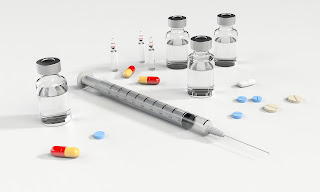Overview Of Route Of Drug Administration
Drug administration route is often classified by the location at which the drug is administered. Drugs are meant for diagnosis, prevention, cure or treatment of various diseases and disorders. They come in lots of different forms and we take them in many different ways. You may take a drug yourself, or a healthcare provider may give it to you. The route of administration of a medication directly affects the drug bioavailability, which determines both the onset and the duration of the pharmacological effect.
 |
| Drug administration |
The choice of routes in which the medication is given depends in;
1. Convenience
2. Compliance
3. Age of the patient
4. Pharmacokinetics
5. Pharmacodynamic profile
6. Desired onset of action
7. State of the patient like conscious or not
Read Also: Injection vs oral drug
Therefore it is crucial to understand the characteristics of the various routes and techniques associated with them. The route used to give a drug depends on three main factors:
1. The part of the body being treated
2. The way the drug works within the body
3. The formula of the drug
Classification Of Route Of Drug Administration
Routes of administration are generally classified by the location at which the substance is applied. An example is oral and parenteral. Routes can also be classified based on where the target of action is. An example is local or systemic. Systemic is further divided into enteral and parenteral. Enteral is drugs administered through the gastrointestinal tract (GIT). Example is oral. Parenteral are drugs administered into the body without passing through the GIT. Parenteral administration can be performed by injection, that is, using a needle (usually a hypodermic needle) and a syringe,or by the insertion of an indwelling catheter. Example is dermal. In this post, we will use classification based on location.
Oral Route
This is the most frequently used route of drug administration. Drugs are placed in the mouth and swallowed. Best taken with a large amount of water. Drugs of this route come in tablets (including chewable), capsule (soft and hard), caplet, liquid (suspension, syrups, emulsion and solution) and powder.
Sublingual/Buccal Route
Applying the drug between the tongue and the lower surface of the mouth (sublingual) or between gums and inner lining of the cheek (buccal), the medication undergoes a passive diffusion through the venous blood in the oral cavity, which bypasses the hepatic portal vein and flows into the superior vena cava. Compared to sublingual tissue, which has a highly permeable mucosa with rapid access to the underlying capillaries, buccal tissue is less permeable and has a slower drug absorption.
Rectal Route
The rectal mucosa is capable of absorbing many soluble drugs into the circulation. Rectal medication may be in suppository form or in liquid form to be administered as a retention enema.
Topical Route
Drugs are applied topically to the skin or mucous membrane of the eye, ear, nose, mouth, vagina, etc. They are available as creams, ointments, liniments, and drops. They can exhibit local or systemic effects. Example is transdermal patch.
Intravenous (IV) Route
The vein carries blood from part of the body back to the heart. Drugs administered into the vein go straight into the heart and pump to all parts of the body almost immediately. Intravenous injection is the most common parenteral route of medication administration. The veins in the upper parts of the body are highly used as it is closest to the heart.
Intramuscular (IM) Route
Drugs can be administered to muscles and absorbed into the body. Different muscles in the body can be used including deltoid, dorsogluteal, ventrogluteal, rectus femoris, or vastus lateralis muscles.
Subcutaneous (SC) Route
Subcutaneous injections are another form of the parenteral route of medication and are administered to the layer of skin referred to as cutis, just below the dermis and epidermis layers. Subcutaneous tissue has few blood vessels; therefore, the medications injected undergo absorption at a slow, sustained rate. Subcutaneous medication can be administered to various sites, including the upper arm's outer area, abdomen avoiding a 2-inch circle around the navel, the front of the thigh, upper back, or the upper area of the buttock behind the hip bone.
Inhalational/pulmonary Route
Gaseous, aerosol mist or ultra-fine solid particle form can be delivered as a drug through the nasal passage or pulmonary route. Breathe in the drug with your nose or suck it in with your mouth. They are used to treat some disease conditions.
Read Also: Why Change Injection Needle After Withdrawing Medication From Vial
Other Routes
There are so many routes of drug administration. However, many are not common.
* Epicutaneous is application onto the skin
* Epidural (synonym: peridural) is injection or infusion into the epidural space
* Intracerebroventricular (into the cerebral ventricles) is administration into the ventricular system of the brain
* Intracerebral (into the cerebrum) is administration by direct injection into the brain
* Intra-arterial is injection into an artery
* Extra-amniotic administration is injection between the endometrium and fetal membranes
* Intracardiac is into the heart
* Intra-articular is into a joint space
* Intradermal is into the skin itself
* Intracavernous injection, an injection into the base of the penis
* Intraosseous infusion is into the bone marrow
* Intraocular is into the eye
* Intradermal is into the skin itself
* Intralesional is into a skin lesion
* Intrauterine
* Intrathecal is into the spinal canal
* Intraperitoneal is infusion or injection into the peritoneum
* Intravitreal injection through the eye
* Intravesical infusion is into the urinary bladder.
* Intravaginal administration in the vagina
* Transmucosal is diffusion through a mucous membrane
* Perivascular administration: perivascular medical devices and perivascular drug delivery systems are conceived for local application around a blood vessel during open vascular surgery

Comments
Post a Comment
Please have your say